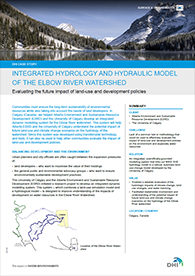Evaluating the future impact of land-use and development policies for the Elbow River Watershed
We helped Alberta Environment and Sustainable Resource Development (ESRD) and the University of Calgary develop an integrated dynamic modelling system for the Elbow River watershed.
 We helped Alberta Environment and Sustainable Resource Development (ESRD) and the University of Calgary develop an integrated dynamic modelling system for the Elbow River watershed.
We helped Alberta Environment and Sustainable Resource Development (ESRD) and the University of Calgary develop an integrated dynamic modelling system for the Elbow River watershed.
This system will help stakeholders understand the potential impact of land-use changes and climate change scenarios on the Elbow River Watershed’s hydrological processes. It combined:
- a cellular automata land-use simulation model
- a spatially-distributed and physically-based hydrological model
We assisted the University of Calgary and Alberta ESRD with the development and calibration of the hydrological model using our MIKE SHE software. Dr. Danielle Marceau and her team of researchers at the University of Calgary selected MIKE SHE (a part of our MIKE by DHI software) because it simulates all the major components of the land-based phases of the hydrologic cycle, including:
- snowmelt
- evapotranspiration
- overland flow
- river channel flow
- unsaturated flow
- groundwater flow
The MIKE SHE model of the Elbow River Watershed was linked with the cellular automata land-use change model developed by the University of Calgary’s Geocomputing Laboratory. The models were linked in order to represent the potential hydrologic impacts of urban growth and land-use change under different climate and policy scenarios. We then calibrated and validated the models against more than 40 years of historical streamflow and snowpack data as well as limited groundwater observations.
At the end of the project, we supplied a calibrated MIKE SHE model that will provide the basis for a detailed evaluation of the hydrologic impacts of:
- climate change
- land-use changes
- water licensing
Read more